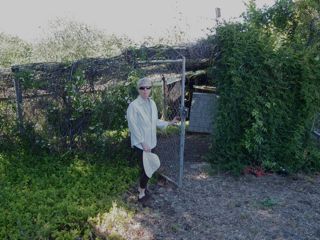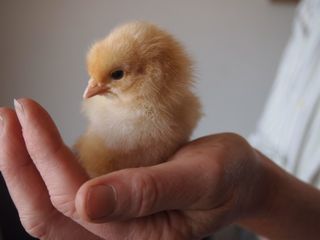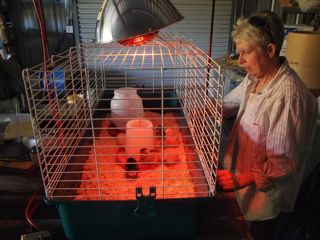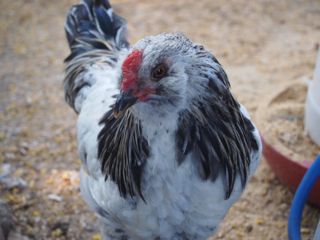

| Chickens |
If you live in Fallbrook, getting chickens seems to be inevitable rite of passage into becoming a small scale farmer. (I think becoming a “farmer” is in your head – we just began several years ago to think of ourselves that way as the garden grew.) The first factor leading us to chickens is that the previous owner had built a chicken coop and and nice one at that. It is big - triangular, 30’ on a side and build like a fortress – covered on all sides including the roof in heavy duty metal fencing.  The second factor leading down “the chicken path” is that cute baby chicks are everywhere in the spring. Every farm store sells them and they are very cute. I had resisted and thought I was safe from temptation because it was getting late in the season. As it was explained to me, you have to get them early in the spring so that they will grown and better able to withstand hot summer weather. I was coming out of the grocery store parking lot the there was the sign “chicks for sale”. Even though I has just bought a bunch of perishables I couldn’t resist – I stopped and went in to check it out. The lady who runs Fallbrook Fertilizer couldn’t be nicer and very excited about chickens. Before 15 minutes had passed, I had purchased 8 chicks of three varieties Buff Orpington, Ameraucana and Cockoo Marans – who makes up these names?  I also purchased a big cage for the first two months before they can be moved to the coop, a heat lamp, shavings, food which were stuffed into the car and home we went. I knew we were now part of the farm community in Fallbrook because she said “keep them in the barn” assuming, of course, we have a barn and we do. It over so fast the perishables were just fine.  Even though it was an impulse purchase, I have thought about it for some time – there are problems, the first being keeping them alive. She suggested we buy 8 chicks because there is an assumption that one or two will be picked off by the various predators in the neighborhood, especially coyotes. There were chickens roaming loose around the stables were I kept my horse and once in a while, you would hear squaking and run to find a blizzard of feathers where a coyote would grab one and drag it of in broad daylight. At two weeks old the chicks have doubled in size and are adorable. Now they stare at you when you come near the cage and jump up on your arm. At 3 weeks, they are definitely outgrowing the cage. We took them out on a “field trip” to the chicken coop. It went very well and we will soon move the cage out to the coop to to get them used to it but still have the security of their cage. Also, we still have to provide heat at night, which will require a very long extension cord for the heat lamp. They will be ready to be fully on their own when they have their final feathers.  At one month, the chickens are permanently in the coop now – they made it clear they wanted to be out of there and have settled in nicely. It is scary to leave them out there at night but we have secured the coop pretty well. Even though we feed them a complete chicken feed, we have introduced greens and they love them – they definitely want fresh product and will ignore wilted greens. If you bring them a head of dandelion greens, they will peck aggressively until there is nothing left. After studying up, I have learned that they eat almost everything we eat (or should eat) - all kinds of greens, most fruits, grains, whole grain bread (see pictures – they love bread). They will also eat chicken, cooked egg and their other favorite, mealworms. Funny story about the worm thing - we have always had a compost pile, which is teeming with bugs of all kinds but we started a separate earthworm "farm" just for the chickens. Turns out they don’t like earthworms – only mealworms – go figure. Meanwhile, while we were going to all this effort to set up the earthworm farm, the regular compost is now teeming with mealworms. I think the chicken poop that I throw in there had mealworm eggs and all of a sudden we have a mealworm supply! At two months, they are fully feathered and showing their personalities. Some are shy and others are curious and fearless. When confronted with something new (and at this stage everything is new) there will be a chorus of their “alarm” cluck but some will be right there checking it out. Our Cockatiel would take months to get used to something new. We discovered their favorite treat is whole wheat bread – Jim will bring some every afternoon and they will practically knock him over to get to it. We have been scrambling to get all the right equipment for raising chickens – and, of course, there is plenty of stuff you can buy. Chicken coops can get very fancy and expensive but since the house came with its own coop we were all set. Of course, we bought $200 worth of concrete to reinforce the structure against critters getting in (it’s not a coop anymore, it’s more like a bunker). We did buy one neat gadget, an automatic water feeder – works like a toilet with a float.  At 2 ½ months, we seem to have one rooster – we hear the crowing early in the morning. We think we know which one is our “dude” – one of the buff orphingtons is larger, has a larger comb and more tail feathers. Hopefully, we have only one rooster – a Buff Orpington - we have no interest in starting a cock fighting operation The rooster in the foreground and a Cockoo Marans in the back.  The rooster  A Cockoo Maran  This beauty is a Ameraucana  Chicken Life Cycles We have been on a chicken “roller coaster” since June 1st when we brought our days old chicks home. At the 5 month mark, we have literally raised our 8 “children” to adolescence and hormones are raging with dire consequences. The experts are supposed to be able to tell the sex of a chick with a high degree of accuracy but the checker must have been having a bad day because we wound up with 5 hens and 3 roosters. We began to suspect this situation at 4 months because of larger combs, longer tail feathers and a bump on their legs that will become sharp spurs. Then at 5 months our suspicions were confirmed - we were getting a chorus of crowing. At first we were told that because the roosters were raised together they would get along and it seemed to be true. The problem was that they were terrorizing the hens. Off I went to study up on roosters and it was an eye opener. First I went back to the book I bought but that author dismissed the entire problem by saying she doesn’t do roosters. All the Urban Homesteading magazines were no help either. Had to go to the poultry ranching websites to get some advice. Here’s the kind of advice I didn’t learn from yuppie homesteading magazines: “Don't ever assume a submissive posture with him, or he might just take your eyes out when you're least expecting it.” Unfortunately they can also hurt the hens and 3 roosters to 5 hens is not good - 10 hens to 1 rooster is more normal. So what were our options? You can keep them but it is very tricky. Check out this website on how to make your chickens think you are the alpha male chicken – amazing stuff but very time consuming: http://shilala.homestead.com/roosters.html Give “the guys” away? Also a problem because they could wind up in the wrong hands and be used for cockfighting – a very cruel end for the birds. Final solution for our roosters? Keep one – the hens are happier with a guy in the house and we want to have chicks in the future. The other two males were given to a reputable breeder and might find homes or might be “processed” (this means dinner). A difficult decision but the only humane one in the circumstance. One of the roosters, the one pictured just above, proved too much for the breeder so he was returned to us and it ended up - on the table.  With the two males gone, life in the coop seems much more settled but the remaining male seems to be confused – probably trying to figure out how he became the alpha male (oh I forgot, I’m supposed to be the alpha male!)  Now we can let them out for finding bugs and weeds to eat. Chicken Diet Feeding our chickens has turned out to be a satisfying activity on several levels – It turns out that they share many of dietary needs. Granted, we don’t scarf down cracked wheat but they also eat greens, fruits, cheese and cooked chicken – no food waste in our house! Also, after some research, I figured out which weeds are OK to feed them. Here’s a list of safe weeds: http://simple-green-frugal-co-op.blogspot.com/2009/05/chickens-eat-my-weeds.html Wheat grass Easy to grow – another source of greens – http://www.rawfoods-livingfoods.com/how-to-grow-wheatgrass.html Pumpkins We talked to a poultry rancher who buys pumpkins after Halloween and just puts them out in the field whole. Their chickens will peck right through to get to the pulp and the seeds. The Chickens get maternal 5 ½ months, the remaining rooster is very clear about having his way with this “harem” and three of the chickens started laying eggs. They are small compared to supermarket eggs and the yolks are deep orange, very round and delicious. It is very satisfying to have our “Gallus domesticus” family into the natural rhythms of chicken life. At 6 months, all the hens are laying eggs. One of the Buff Orphingtons was the last to produce and her first egg was greeted with great fanfare. I went into the coop to find all the hens and the rooster gathered around one of the nesting boxes making a racket and looking in on the Buff “O”s in the box. They honestly looked like a cheerleaders on the sidelines encouraging her on. Her first egg was very small but seemed to be greatly appreciated by the entire family!  Eggs from Buff Orpington (light brown), Ameraucana (light blue) and Cockoo Marans (dark brown) Watched them settle down for the evening – there is a lot of moving around and jostling for space – the prime spots seems to be next to the rooster – several hens surround him and wedge themselves under his great expanse of down and feathers. He was very patient with them. |
Food Chain Farm Homepage and Table of Contents |
| See us on the HPWREN Webcam: http://hpwren.ucsd.edu/cameras/RedMtn.html |